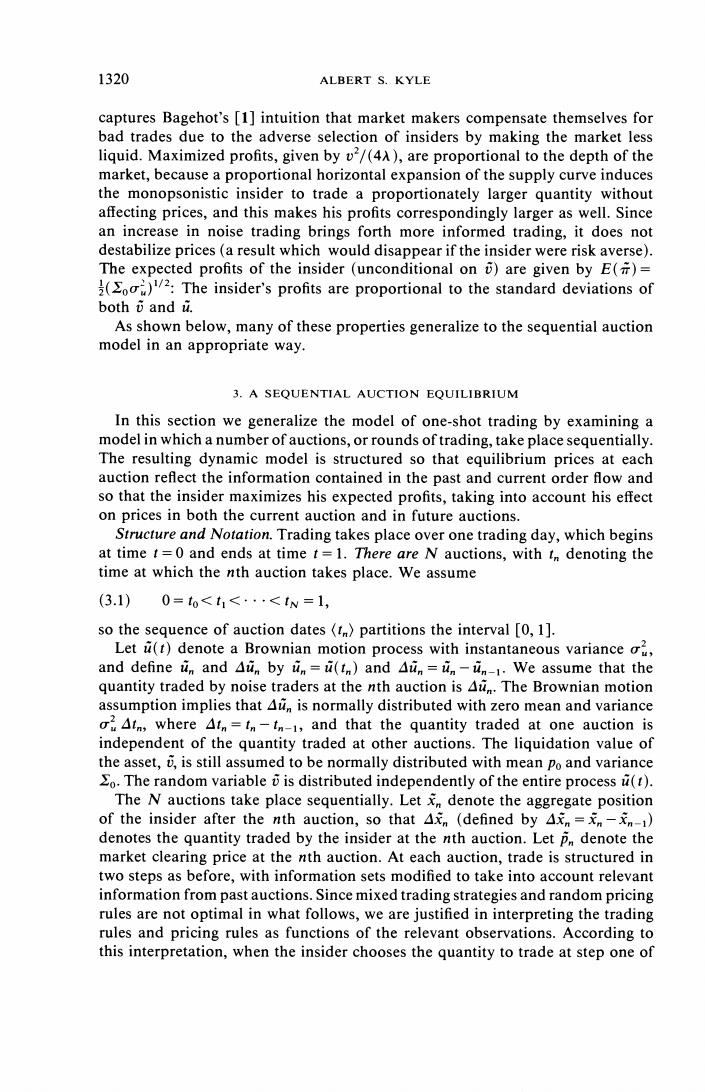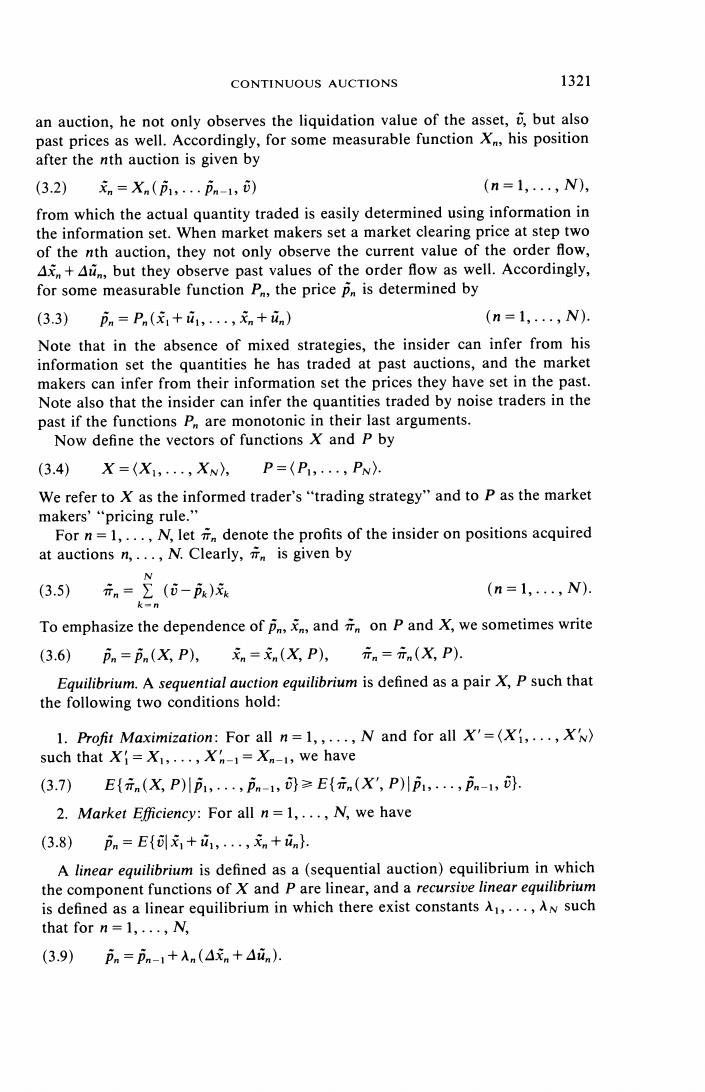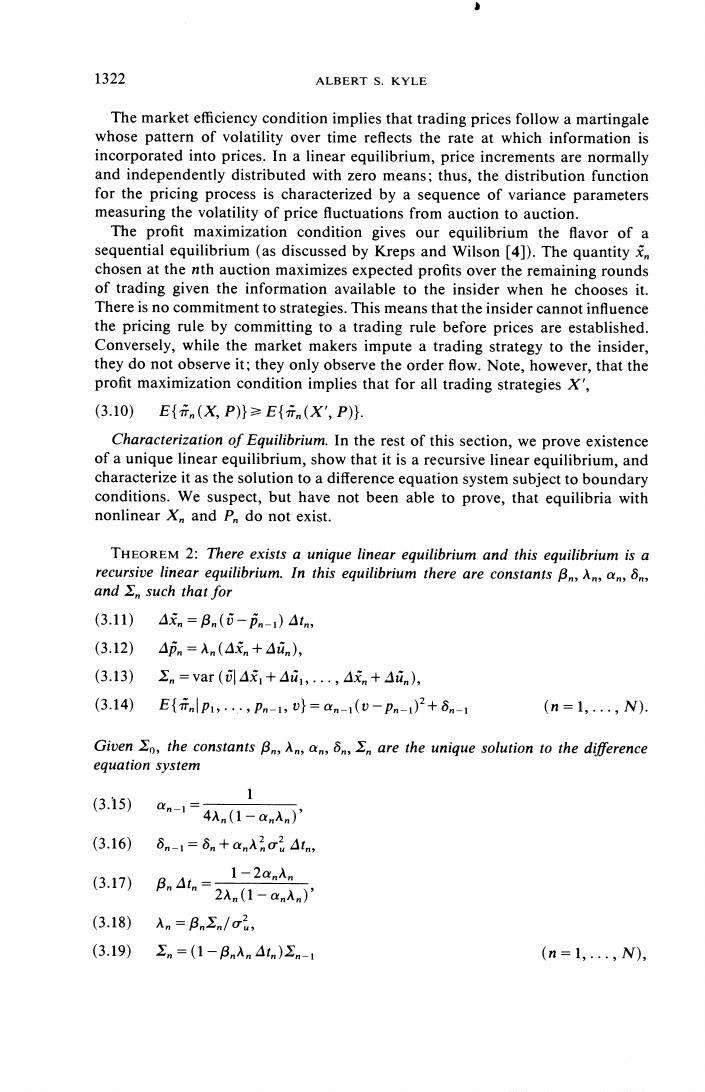
1320 ALBERT S.KYLE captures Bagehot's [1]intuition that market makers compensate themselves for bad trades due to the adverse selection of insiders by making the market less liquid.Maximized profits,given by v/(4A),are proportional to the depth of the market,because a proportional horizontal expansion of the supply curve induces the monopsonistic insider to trade a proportionately larger quantity without affecting prices,and this makes his profits correspondingly larger as well.Since an increase in noise trading brings forth more informed trading,it does not destabilize prices(a result which would disappear if the insider were risk averse). The expected profits of the insider (unconditional on are given by E()= )/2:The insider's profits are proportional to the standard deviations of both o and u. As shown below,many of these properties generalize to the sequential auction model in an appropriate way. 3.A SEQUENTIAL AUCTION EQUILIBRIUM In this section we generalize the model of one-shot trading by examining a model in which a number of auctions,or rounds of trading,take place sequentially. The resulting dynamic model is structured so that equilibrium prices at each auction reflect the information contained in the past and current order flow and so that the insider maximizes his expected profits,taking into account his effect on prices in both the current auction and in future auctions. Structure and Notation.Trading takes place over one trading day,which begins at time t=0 and ends at time t=1.There are N auctions,with tn denoting the time at which the nth auction takes place.We assume (3.1) 0=to<t<·<tw=1, so the sequence of auction dates(t)partitions the interval [0,1]. Let a(t)denote a Brownian motion process with instantaneous variance and define tin and Atn by tn=(t)and Ain=n1.We assume that the quantity traded by noise traders at the nth auction is A.The Brownian motion assumption implies that Adn is normally distributed with zero mean and variance oAt,where At=tn-t-1,and that the quantity traded at one auction is independent of the quantity traded at other auctions.The liquidation value of the asset,is still assumed to be normally distributed with mean po and variance So.The random variable o is distributed independently of the entire process u(t). The N auctions take place sequentially.Let denote the aggregate position of the insider after the nth auction,so that A (defined by = denotes the quantity traded by the insider at the nth auction.Let pr denote the market clearing price at the nth auction.At each auction,trade is structured in two steps as before,with information sets modified to take into account relevant information from past auctions.Since mixed trading strategies and random pricing rules are not optimal in what follows,we are justified in interpreting the trading rules and pricing rules as functions of the relevant observations.According to this interpretation,when the insider chooses the quantity to trade at step one of

CONTINUOUS AUCTIONS 1321 an auction,he not only observes the liquidation value of the asset,but also past prices as well.Accordingly,for some measurable function X,his position after the nth auction is given by (3.2)n=Xn(户1,…户n-1,) (n=1,.,N), from which the actual quantity traded is easily determined using information in the information set.When market makers set a market clearing price at step two of the nth auction,they not only observe the current value of the order flow, A+At,but they observe past values of the order flow as well.Accordingly, for some measurable function P,the price p is determined by (3.3)pn=Pn(元1+i1,,元n+an) (n=1,.,N). Note that in the absence of mixed strategies,the insider can infer from his information set the quantities he has traded at past auctions,and the market makers can infer from their information set the prices they have set in the past. Note also that the insider can infer the quantities traded by noise traders in the past if the functions P are monotonic in their last arguments. Now define the vectors of functions X and P by (3.4)X=(X1,,XN),P=(P,,PN) We refer to X as the informed trader's"trading strategy"and to P as the market makers'"pricing rule." For n=1,...,N,let denote the profits of the insider on positions acquired at auctions n,...,N.Clearly,is given by N (3.5) 元n=∑(i-p) (n=1,..,N) To emphasize the dependence of p,,and on P and X,we sometimes write (3.6) pn=pn(X,P),xn=元n(X,P),方n=元n(X,P): Equilibrium.A sequential auction equilibrium is defined as a pair X,P such that the following two conditions hold: 1.Profit Maximization:For all n =1,,...,N and for all X'=(X,...,XN) such thatX=X1,...,X1=Xn-1,we have (3.7) E{元n(XP川i1,,户n-1,≥E{元n(X',P)川i,…,in-l,. 2.Market Efficiency:For all n=1,...,N,we have (3.8)pn=E{x1+a1,,n+in} A linear equilibrium is defined as a(sequential auction)equilibrium in which the component functions of X and P are linear,and a recursive linear equilibrium is defined as a linear equilibrium in which there exist constants A1,...,AN such that for n=1,...,N, (3.9)币n=pn-1+入n(△元n+4in)

1322 ALBERT S.KYLE The market efficiency condition implies that trading prices follow a martingale whose pattern of volatility over time reflects the rate at which information is incorporated into prices.In a linear equilibrium,price increments are normally and independently distributed with zero means;thus,the distribution function for the pricing process is characterized by a sequence of variance parameters measuring the volatility of price fluctuations from auction to auction. The profit maximization condition gives our equilibrium the flavor of a sequential equilibrium(as discussed by Kreps and Wilson [4]).The quantity chosen at the nth auction maximizes expected profits over the remaining rounds of trading given the information available to the insider when he chooses it. There is no commitment to strategies.This means that the insider cannot influence the pricing rule by committing to a trading rule before prices are established. Conversely,while the market makers impute a trading strategy to the insider, they do not observe it;they only observe the order flow.Note,however,that the profit maximization condition implies that for all trading strategies X', (3.10)E{n(X,P)}≥E{元n(X',P) Characterization of Equilibrium.In the rest of this section,we prove existence of a unique linear equilibrium,show that it is a recursive linear equilibrium,and characterize it as the solution to a difference equation system subject to boundary conditions.We suspect,but have not been able to prove,that equilibria with nonlinear X and P do not exist. THEOREM 2:There exists a unique linear equilibrium and this equilibrium is a recursive linear equilibrium.In this equilibrium there are constants B,An,an,8n, andΣsuch that for (3.11) △xn=Bn(i-pn-1)4tn, (3.12) 4pn=入n(4元n+△in), (3.13) En=var(△x1+△i1,,△n+Ain), (3.14) E(inlpi;....Pn-1,0}=an-1(v-Pn-1)2+8n-1 (n=1.,N). Given o,the constants B,An,an,6,E are the unique solution to the difference equation system 1 (3.15) an-1=4n(1-an入n' (3.16) 6n-1=6n+an7c41n, (3.17) 1-2an入m Bn△1n-2Xn1-an (3.18) An=BnΣn/o2, (3.19) Σn=(1-Bn入m4tn)Σn-1 (n=1,.,N)